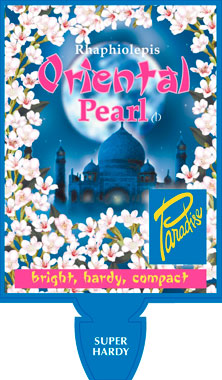Compact, low maintenance, spot-free Rhaph ideal for low hedges & borders. Dark green leathery foliage throughout the year. White flowers in winter/spring.
Rhaphiolepis Oriental Pearl is a compact low growing shrub producing an abundance of flowers winter/spring. Attractive white flowers with pink stamens are borne on tight dense rounded bushes. Hardy to a very wide range of conditions.
Will grow Australia wide, they are tolerant of both heat and frost but may need protection in extreme situations especially while young.
Coastal or salt water pool plantings
Containers
Low maintenance gardens
Small hedges or borders
Mass planting
- Bee Attracting
- Borders
- Containers
- Exotic
- Foliage
- Fragrance
- Hedging
- Scented Flowers
- Shrubs
- Topiary
Full sun or part shade
Soil pH should be in the neutral range and poor or heavy soils should be improved with plenty of decomposed organic matter prior to planting and raised beds are recommended for areas with heavy clay soils.
Good drainage is required. Raphiolepis will not tolerate waterlogged soils.
Space plants 60cm apart for a hedge or border.
Planting holes should be approximately twice the width and depth of the pot to be planted and back filled with top soil improved with organic matter.
During establishment period deep watering is recommended to encourage a deep root system. Soil should be kept moist but not water logged. Watering can be slowly reduced as plants establish and begin to grow strongly.
Mulching will help to retain moisture levels in the soil and protect surface roots from extremes of temperature. Mulch layer should be 10cm deep and kept 10cm away from the base of the plant to help ensure adequate airflow around the stem.
Lightly prune after flowering if needed.
Feed plants twice a year in spring and summer with a high quality complete fertiliser.
 Look out for this label in all good garden centres.
Look out for this label in all good garden centres.